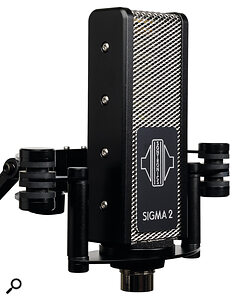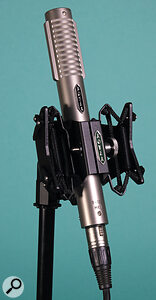Looking for that smooth ribbon tone with the convenience of a modern mic? Look no further...
Ribbon mics can be a useful addition to any collection, with their characteristically smooth high‑frequency response and low‑mid emphasis often providing a more flattering sound on sources that can come across as a little harsh when captured with a capacitor mic. Recognising that the low output of traditional passive designs can be quite demanding, often requiring a high‑quality preamp capable of providing a significant amount of gain — or the use of in‑line boosters — many manufacturers now offer versions fitted with phantom‑powered active preamps or buffers to deliver a much hotter output. In this month’s Spotlight, we take a look at some of the obvious brands to check out if you’re on the lookout for an active ribbon mic.
The low output of traditional passive designs can be quite demanding, often requiring a high‑quality preamp...
Sontronics
Sontronics currently make three active ribbon microphones, all of which are designed, developed and hand‑built by the company in the UK. High‑quality components are used throughout, with each model employing a custom‑wound transformer manufactured to the company’s own design. They also utilise RFI filtering in their circuitry to provide maximum resistance to interference.
The Sigma 2 is an updated version of the company’s first ever ribbon design, and is somewhat of an ‘all‑rounder’ that is recommended for use on a wide range of sources from vocals and spoken word to string, woodwind and brass instruments. The Delta 2 is of a similar design, but features a lower sensitivity, a more robust ribbon and more internal protection, allowing it to withstand higher SPLs. The Apollo 2 uses a pair of ribbon motors in a Blumlein configuration, making it possible to capture stereo recordings with a single microphone.
Sigma 2 £829$1199, Delta 2 £829$1199, Apollo 2 £1999$2699
sE Electronics
There are two active ribbon mics in sE’s range. The RNR1 was the first of three microphones developed in a collaboration with legendary audio equipment designer Rupert Neve. The design employs separate transformers for the capsule and output stages, connected via a discrete Class‑A circuit that compensates for the ribbon’s high‑frequency roll‑off. This allows the microphone to offer the ‘warm’ low‑ and mid‑range character associated with ribbon designs, but with an extended high‑frequency response. A switchable 100Hz high‑pass filter is present, and the RNR1 is capable of withstanding a maximum SPL of 137dB. It also comes supplied with a custom shockmount.
The VR2 also offers a wider frequency response than many ribbon designs, this time using a mechanical diffusor designed by sE’s CEO Siwei Zou to extend the response up to 18kHz. It comes supplied with its own custom shockmount, and can withstand SPLs of up to 135dB.
RNR1 £1199$1999, VR2 £382$499
Golden Age
Golden Age Project’s R1 range offers a selection of mics inspired by RCA’s iconic 44, promising to deliver high‑end performance and vintage character at an affordable price point. The R1 Active MkIII and the R1 Tube Active are of a similar design, but the latter uses a 12AX7 valve‑based buffer amplifier in place of the former’s FET circuitry.
The premium Golden Age Premier range includes the R1A, which uses high‑quality components throughout, with a discrete amplifier joined by a Lundahl 1927A transformer. Output levels across the range are similar to those of many capacitor microphones, meaning that quiet sources can be recorded without high‑gain preamps — and with a maximum SPL handling of up to 160dB (165dB for the Tube version), they can capture even the loudest of sources. The R1A and R1 Active MkIII also feature a switchable 160Hz high‑pass filter and ‑10dB pad.
R1 Active MkIII £219$229, R1 Tube Active £339$399, Premier R1A £519$599
AEA
AEA’s rich heritage dates back to 1976, when they began servicing RCA ribbon mics after the company’s microphone division closed. In 1998, as the sole manufacturer of parts for the RCA 44, AEA decided to release their own version of the iconic mic, the R44C.
They have since continued to advance ribbon technology, and their current range offers a choice of three active designs. The A440 is a premium version of their original design equipped with a Lehle transformer, and retains the same sonic character with an additional 18dB of output and significantly improved noise performance.
The N22 has then been optimised for close‑miking, with a limited proximity effect and rugged construction allowing it to be placed closely to loud sources whilst retaining a balanced frequency response. Finally, the KU5A is an end‑address design which, unusually for a ribbon mic, features a supercardioid polar pattern rather than figure‑of‑eight.
A440 £6499$6799, N22 £1099$1099, KU5A £1299$1499
Audio‑Technica
 Audio‑Technica AT4080 and AT4081
Audio‑Technica AT4080 and AT4081
There are two active ribbon models in Audio‑Technica’s extensive range of microphones: the AT4080 and AT4081. Both aim to deliver the smooth, warm character associated with ribbons, but with a more mechanically robust construction than vintage alternatives.
The former is the larger of the two models, with a low‑end response extending slightly further than its smaller sibling, which features a more compact, ‘stick’ profile that helps to maximise placement options. The AT4080 comes supplied with a custom shockmount, whilst the AT4081 ships with an isolation stand clamp.
AT4080 £849$1049, AT4081 £639$749
Rode
Rode’s only ribbon, the NTR, promises extremely high‑end performance at an affordable price. A laser‑cut 1.8‑micron‑thick ribbon allows it to offer an extended high‑frequency response, with the cutting process used during its manufacture said to result in smoother edges and increased longevity. The microphone’s design minimises acoustic interactions between the body and ribbon, and the frame surrounding the ribbon has been placed in the null of the polar pattern to reduce resonances. A sturdy internal shockmount design also means that the NTR can be mounted directly on a stand without an additional shockmount.
NTR £689$799
Royer Labs
Founded by David Royer in 1998 with the aim of delivering new and unique ribbon designs, Royer Labs are often credited as the company behind the modern ribbon mic resurgence. In 2002, they released the world’s first phantom‑powered ribbon mic, the R‑122. The current R‑122 MkII builds on its success, adding a ‑15dB pad to help tackle loud sources, and a 100Hz, 6dB/octave high‑pass filter to counteract bass build‑up caused by the proximity effect when close‑miking.
As with all of the company’s R‑series designs, the mic features Royer’s offset ribbon technology, which helps to maintain a full frequency response during high SPL recordings by placing the ribbon closer to the front side of the microphone.
R‑122 MkII £2025$1899
Ocean Way Audio
Ocean Way Audio are renowned for their no‑compromise approach to equipment design, and their RM1‑B is no exception. It is a large microphone with a striking visual design, weighs a substantial 3.4kg, and is said to feature the strongest magnetic field present in any ribbon microphone. Its construction promises to deliver resonance‑free acoustical performance, with all‑discrete output circuitry offering a clean and natural sound along with excellent noise performance.
The RM1-B is recommended for use on a wide variety of sources, although the company advise against close placement on instruments such as kick drums and bass amps to avoid damaging the ribbon element.
RM1‑B $3250$3250
Cloud Microphones
Cloud’s ribbon mics were designed in collaboration with Stephen Sank, whose father, Jon R Sank, was involved in designing many of RCA’s iconic microphone models.
As its name suggests, the Cloud 44 represents the pair’s take on RCA’s legendary 44‑series designs. The Cloud 44‑A takes things a step further, employing a built‑in version of the discrete Class‑A preamp circuitry used in the company’s popular range of Cloudlifter devices.
Being inspired by the early RCA designs, the mic offers a traditional ribbon sound, and features switchable Voice and Music tone options, with the former cutting low end for a more natural sound when close‑miking vocals.
44‑A £1699$1499
Pinnacle Microphones
 Pinnacle Fat Top II Active/Passive
Pinnacle Fat Top II Active/Passive
The Pinnacle Microphones (formerly Cascade) range is predominantly made up of passive models, but there is an interesting exception in the form of the Fat Top II Active/Passive, which features a switch that allows it to operate as either a passive or active ribbon mic. With the active circuitry engaged, the ribbon is kept consistently loaded, and up to 20dB of extra gain is delivered to the output.
The mic is also equipped with a Lundahl LL2913 transformer — which is an optional upgrade on the company’s other offerings — that is said to offer an extended frequency range and improved definition.
Fat Top II Active Passive €699$689
HUM Audio Devices
HUM Audio Devices’ ARM‑1L and ARM‑1S appear almost identical to look at, and at a glance are distinguishable only by the colour of the lettering around their bodies. The difference is more significant than it seems, though: the letters in their name denote the use of two‑inch (Long) and one‑inch (Short) ribbon elements. As a result, the former is said to offer a more contoured sound which imparts a little more character, whilst the latter is smoother and more tonally balanced. Both employ discrete active circuitry, and feature a switchable 50/100 Hz high‑pass filter.
ARM‑1L & ARM‑1R £1905.60$2000
Extinct Audio
Extinct Audio’s BM9A has been designed to offer the exact sound of their BM9 Viking, but with an active output stage that provides an additional 22dB of gain. Visually, it draws inspiration from vintage Bang & Olufsen designs, but its modern circuitry and manufacturing techniques offer much improved noise performance.
The high‑frequency response is said to be as smooth and detailed as you’d expect from a high‑end ribbon, with a rich bottom end that is particularly evident when close‑miking thanks to a strong proximity effect.
BM9A £999£999
Peluso Microphone Lab
Peluso’s TR 14 differs slightly in that, being a valve microphone, its output circuitry draws power from a dedicated PSU rather than phantom power. The use of a valve also imparts some additional harmonics, although the effect is subtle — Peluso say that the TR 14 delivers natural‑sounding results that respond well to EQ.
The rear side of the mic has slightly more low‑end roll‑off due to the ribbon being placed slightly forward of the magnetic centre, a useful feature that helps to counter proximity effect when close‑miking, if required.
TR 14 £999$1116
ART
ART’s AR5 has been designed to offer the sonic qualities associated with classic ribbon designs, whilst its active output stage ensures a consistent performance regardless of the destination input. It offers an extended frequency response when compared to many older ribbon designs, and will withstand a maximum SPL of 150dB.
The mic comes supplied with a shockmount that promises to virtually eliminate handling noise and vibrations as well as making it easier to position, and plenty of protection is offered by a rugged body construction and steel mesh grille.
AR5 $159.99$159.99
Samar
Samar say that their VL37A ribbon mic combines a vintage vibe with a modern sound, and offers a versatile solution that works well on everything from classical recording sessions to guitar amps and drum overheads. Its motor structure is based on their acclaimed MF65 model (also used in the passive VL37 version), and every model is meticulously built by hand and fine‑tuned to ensure consistency between each unit. It boasts a ruler‑flat frequency response that extends beyond 25kHz, and is only 0.43dB down at 20Hz!
VL37A £1273.20$1199
Mesanovic
The Mesanovic Model 2A offers the same extended frequency response and sonic character as the company’s passive Model 2 version, a mic praised for its detailed and natural sound.
Where the active version differs from many is that the active electronics do not provide any additional gain: they are used purely as an impedance buffer. Combined with the mic’s high‑turn‑ratio transformer, however, the circuitry results in an additional 13dB of output gain compared to the passive version, along with extremely low self‑noise.
Model 2A £1165.83$1199















